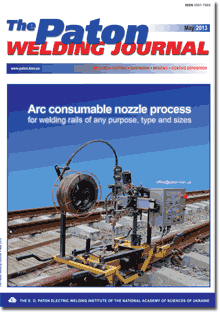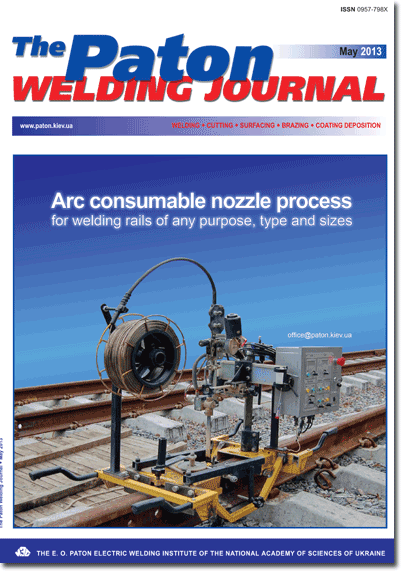| 2013 №05 (02) | 2013 №05 (04) |

The Paton Welding Journal, 2013, #5, 21-28 pages
PROBLEMS OF EXAMINATION OF MODERN CRITICAL WELDED STRUCTURES
V.I. MAKHNENKO
E.O. Paton Electric Welding Institute, NASU, Kiev, Ukraine
Abstract
An important stage of diagnostics of the state of critical welded structures is prediction of their residual life based on strength analysis by limiting state. In the absence of crack-like raisers spontaneous macrofailure of structural elements in a number of cases is the result of plastic instability, related to porosity initiation and development. This work deals with the main problems of modelling tough fracture of welded structures and proposes methodological basis for description of mechanisms of their limiting state. In particular, complex finite element models of simultaneous development of 3D stress-strain state of elastoplastic material with strengthening and pore formation have been developed. Condition of initiation of tough fracture pores is determined by limit value of Odqvist parameter, and pore development Е by Rice-Tracey law. Thus, limiting state of a structure at developed plastic flow of metal is due to discontinuity growth, local redistribution of load and reduction of actual load-carrying cross-section. Application of the proposed methodology was illustrated by examples of calculation of limiting inner pressure of pipeline elements, allowing for initial stress-strain state at site and repair welding, structural inhomogeneity, and surface defects of local wall thinning. It is shown that in the absence of geometrical raisers, physical inhomogeneity has little influence on limiting load at static loading of the considered welded structures. This is in agreement with the available experience of pipeline system operation that proves applicability of developed approaches of numerical analysis for effective solution of practical problems of diagnostics of the state of modern welded structures. 12 Ref., 1 Table, 4 Figures.
Keywords: tough fracture, pore formation, mathematical modelling, stress-strain state, limit load
Received: 19.02.13
Published: 28.05.13
References
1. Makhnenko, V.I. (2006) Resource of safe service of welded joints and assemblies of current structures. Kiev: Naukova Dumka.
2. (2000) Fitness-for-service. American Petroleum Institute Recommended Practice 579. 1st ed.
3. Savruk, M.P. (1988) Fracture mechanics and strength of materials: Refer. Book. Vol.2: Stress intensity factors in bodies with cracks. Ed. by V.V. Panasyuk. Kiev: Naukova Dumka.
4. Kurkin, S.A., Lukianov, V.F. (1967) On strength of welded vessels of high strength steels. Svarochn. Proizvodstvo, 9, 1-3.
5. Karzov, G.P., Margolin, B.Z., Shvetsova, V.A. (1993) Physico-mechanical modeling of fracture processes. St.-Petersburg: Politekhnika.
6. McClinton, F., Argon, A. (1970) Deformation and fracture of materials. Moscow: Mir.
7. Rybin, V.V. (1986) Large plastic deformations and fracture of metals. Moscow: Metallurgiya.
8. Hancock, I., Mackenzie, A.C. (1976) On the mechanism of ductile failure a high strength steel subjected in multi-axial stress state. J. Mech. Phys. Solids, 24(213), 147-149.
9. Makhnenko, V.I. (1976) Computational methods of investigation of welding stress and strain kinetics. Kiev: Naukova Dumka.
10. Makhnenko, V.I., Velikoivanenko, E.A., Makhnenko, O.V. et al. (2000) Investigation of the influence of phase transformations on residual stresses in circumferential welding of pipes. The Paton Welding J., 5, 2-7.
11. Makhnenko, V.I., Velikoivanenko, E.A., Rozynka, G.F. et al. (2012) Consideration of pore formation at estimation of limiting state in zone of pressure vessel wall thinning defect. Ibid., 12, 2-8.
12. Kiefner, J.F., Bruce, W.A., Stephens, D.R. (1994) Pipeline repair manual. Houston: Technical Toolboxes.
Suggested Citation
V.I. MAKHNENKO (2013) PROBLEMS OF EXAMINATION OF MODERN CRITICAL WELDED STRUCTURES. The Paton Welding J., 05, 21-28.The cost of subscription/purchase order journals or individual articles
| Journal/Currency | Annual Set | 1 issue printed |
1 issue |
one article |
| TPWJ/USD | 384 $ | 32 $ | 26 $ | 13 $ |
| TPWJ/EUR | 348 € | 29 € | 24 € | 12 € |
| TPWJ/UAH | 7200 UAH | 600 UAH | 600 UAH | 280 UAH |
| AS/UAH | 1800 UAH | 300 UAH | 300 UAH | 150 UAH |
| AS/USD | 192 $ | 32 $ | 26 $ | 13 $ |
| AS/EUR | 180 € | 30 € | 25 € | 12 € |
| SEM/UAH | 1200 UAH | 300 UAH | 300 UAH | 150 UAH |
| SEM/USD | 128 $ | 32 $ | 26 $ | 13 $ |
| SEM/EUR | 120 € | 30 € | 25 € | 12 € |
| TDNK/UAH | 1200 UAH | 300 UAH | 300 UAH | 150 UAH |
| TDNK/USD | 128 $ | 32 $ | 26 $ | 13 $ |
| TDNK/EUR | 120 € | 30 € | 25 € | 15 € |
AS = «Automatic Welding» - 6 issues per year;
TPWJ = «PATON WELDING JOURNAL» - 12 issues per year;
SEM = «Electrometallurgy Today» - 4 issues per year;
TDNK = «Technical Diagnostics and Non-Destructive Testing» - 4 issues per year.


